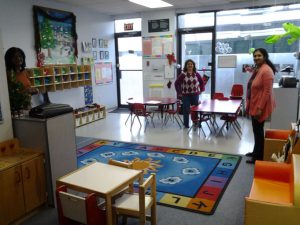SPO Highlight: Catholic Cross Cultural CNC Program

The process of child observations is a key strategy used in CNC programs to plan for each child. Observations are a way to collect data on the child their interests and their growth. How this is done varies from program to program.
At Catholic Cross Cultural, observations and documentations in the CNC programs took on a new meaning when Monica Zheng took on the role of site administrator. She introduced a model that moved away from just collecting information when the child enters the program to a more defined portfolio system.
The idea came from her experience in settlement work with adults. Adult newcomers were utilizing a portfolio model to track their gains through their settlement experiences. She knew just how much the creation of settlement plans and portfolios help newcomers adapt to their new country. This includes assessment, evaluation of short-term/long-term goals, documentation, and follow-up. It gave her the idea to look at a similar process that could support immigrant children. Plus, it could give parents a better understanding of their child’s learning and development.
“If you write something like ‘the child has participated in the program today’ it doesn’t tell much about what the child is learning. For example, is the child is starting to cooperate and line up to wash hands? We want more details so we can see if the child is meeting the skills and take appropriate actions,” says Zheng.
Zheng worked with her CNC team to restructure the child profile. Now, the profiles include artifacts and activities that the child is doing in the centre. Building this profile starts when a child enters the program. First, parents complete registration and health/safety forms. Then, staff ask questions about the child. The responses help caregivers learn about the child’s interests, preferences, and routines.
Each month, the CNC team develops age-related:
- themes and goals in the areas of social, emotional, communication, physical, and language and literacy.
- associated activities that will allow them to assess the children and document outcomes.
Then, each day, they decide which children to focus on and what to observe for each activity. Caregivers assess children’s learning skills and make notes on the individual profiles. They include artifacts of artwork, activities, and pictures to show the goals met in the different areas of development. Monthly reports measure outcomes and explain how the children have progressed.
Caregivers hold regular meetings with parents to update them as to their child’s learning progress. The profile is a reference point to discuss any concerns, provide resources, and suggest activities for home. Every few weeks, they give activity sheets to parents, but artwork and photos remain in the portfolio. When the child leaves the program, parents can take the portfolios as a record to show growth.
This method benefits caregivers in three ways:
- Assessment becomes part of the daily routine, instead of something they just fit in when they have time.
- They are more aware and active in planning what to do when children do not meet goals.
- They question their methods and reflect on ways to improve.
It also benefits the children. Profiles are a great way to quickly identify and respond to concerns. Artifacts allow parents to see their child’s progress and find out about any difficulties. From there, they can follow up at home.
These benefits are proof that if you change the process, you can also change the outcomes.






